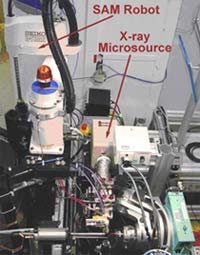
Handy Links
SLAC News Center
SLAC Today
- Subscribe
- Archives: Feb 2006-May 20, 2011
- Archives: May 23, 2011 and later
- Submit Feedback or Story Ideas
- About SLAC Today
SLAC News
Lab News
- Interactions
- Lightsources.org
- ILC NewsLine
- Int'l Science Grid This Week
- Fermilab Today
- Berkeley Lab News
- @brookhaven TODAY
- DOE Pulse
- CERN Courier
- DESY inForm
- US / LHC
SLAC Links
- Emergency
- Safety
- Policy Repository
- Site Entry Form

- Site Maps
- M & O Review
- Computing Status & Calendar
- SLAC Colloquium
- SLACspeak
- SLACspace
- SLAC Logo
- Café Menu
- Flea Market
- Web E-mail
- Marguerite Shuttle
- Discount Commuter Passes
-
Award Reporting Form
- SPIRES
- SciDoc
- Activity Groups
- Library
Stanford
Around the Bay
Still Running at SSRL
 The annual shutdown of SPEAR3 brings anything but idleness to SSRL. Having the storage ring switched off gives engineers and scientists time to make upgrades and repairs, keeping the beehive of activity at the lab humming. And just because no x-rays shine down SPEAR3's beamlines, that doesn't mean scientific research comes to a halt.
The annual shutdown of SPEAR3 brings anything but idleness to SSRL. Having the storage ring switched off gives engineers and scientists time to make upgrades and repairs, keeping the beehive of activity at the lab humming. And just because no x-rays shine down SPEAR3's beamlines, that doesn't mean scientific research comes to a halt.
Of the recent technical achievements at SSRL, perhaps the one that has most enhanced the scientific productivity of the macromolecular crystallography user community is the robotic sample-handling system, in use on all six crystallography beamlines (see SLAC Today story here). But each year, even as those robots remain ready for action around the clock, the annual shutdown leaves researchers with three months of darkened beamlines and, subsequently, idle robots. In 2003, as a means to bridge that gap in the calendar, scientists finally found a way for the robot at Beamline 9-2 to earn its keep during the down time.
SSRL researchers kept the data flowing using a toaster-sized portable x-ray source called the MicroMax-002 (manufactured by Rigaku), originally installed during the 2003 SPEAR3 upgrade. This "microsource" has proved crucial to the ongoing work of many projects, in particular those of the Joint Center for Structural Genomics (JCSG), which can now continue screening protein crystals throughout the shutdown. As suitable samples are identified, they are taken to other synchrotron labs for further study. Using Beamline 9-2 as a screening mill in this way allows the JCSG staff based at SSRL to maintain their productivity throughout the year, as the project strives to map out all the proteins necessary for life.
"The ability of the robot to work unattended is the key technology that makes it possible to use the microsource," said SSRL researcher Mitchell Miller, who oversaw the installation of the MicroMax-002.
When compared to the main storage ring, the MicroMax-002 is a much weaker x-ray source, taking 10 minutes to do what SPEAR3 can do in a few seconds. But even at that rate, JCSG researchers can scan 400 samples per week, which is as fast as the lab can produce them.
In the future, researchers hope to use the MicroMax-002 during SSRL's regular operational period as a development tool, enabling tests of new beamline equipment without disrupting ongoing research.
—Brad Plummer
SLAC Today, August 31, 2006
Above image: The microsource x-ray generator, along with the SSRL Automated sample Mounting (SAM) robot. (Click on image for larger version.)